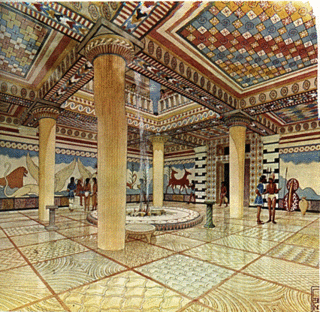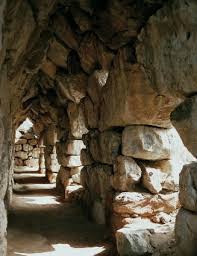If you’re diving into ancient architecture or art history, the term a mycenaean megaron consists of a art history quizlet might have popped up in your readings. So, what is a Mycenaean megaron, and why does it matter in the world of art history?
Simply put, a a mycenaean megaron consists of a art history quizlet is a central, significant structure found in the palaces of ancient Greece, specifically during the Mycenaean period (1600–1100 BCE). This structure was a large, rectangular hall that served as the focal point for both social and ceremonial activities. Picture it as the heart of the palace, where leaders would gather to host banquets or make important decisions.
But let’s not just settle on the basic definition. A megaron isn’t just a cool architectural term— it’s a window into the art and culture of an entire civilization.
The Megaron’s Design: More Than Just Walls
When we talk about the a mycenaean megaron consists of a art history quizlet we’re looking at more than just a building.
A megaron typically had a few key features that made it stand out:
1. A Large Central Room
The megaron’s most prominent feature was its central room. It often included a hearth or fire pit in the middle, used for warmth and cooking. This was a gathering space, a place for royal ceremonies, feasts, or even storytelling.
2. A Porch with Columns
Most megara had a grand porch, supported by columns. Think of this as a a mycenaean megaron consists of a art history quizlet ” for visitors. It was a symbol of power and authority, a place where people could admire the grandeur before stepping into the main room.
3. An Axial Plan
The layout of the megaron was often designed in an axial form. This means that everything, from the entrance to the hearth, was aligned along a central axis. The symmetry here wasn’t just for aesthetic appeal— it conveyed the organization and structured order of Mycenaean society.
4. Decorative Elements
Some megarons featured beautiful frescoes or painted walls. These paintings often depicted daily life, battles, or mythological scenes. So, while the building itself was functional, it also told stories about the people who lived there.
Why Does the a mycenaean megaron consists of a art history quizlet Matter in Art History?
When you look at the a mycenaean megaron consists of a art history quizlet through an art history lens, you’re seeing a blend of architecture, social life, and artistic expression.
1. Cultural Insights
The megaron was a reflection of the a mycenaean megaron consists of a art history quizlet culture. It showed how they organized their space to reinforce authority and the role of the ruler. The megaron, with its grand size and rich decoration, was a direct message to anyone who visited: this was a place of power, wealth, and influence.
2. Architectural Innovation
This structure influenced later Greek architecture, especially the design of temples. The idea of a central space with columns around it? That was the blueprint for some of the most famous buildings in history, like the Parthenon. So, understanding the megaron helps us trace the evolution of Greek architecture.
3. Artistic Expression
The frescoes and decorations found in a mycenaean megaron consists of a art history quizlet help us understand the values, stories, and daily life of the time. For example, some frescoes depict scenes of warriors in battle or gods in mythology. These visual representations help historians and art enthusiasts piece together the cultural fabric of the Mycenaeans.

FAQs About the Mycenaean Megaron: Answers You Need!
Let’s tackle some burning questions you might have about the a mycenaean megaron consists of a art history quizlet
What Is the Difference Between a Megaron and a Temple?
At first glance, you might think a megaron is similar to a temple. Both have central spaces, columns, and are used for ceremonial purposes. However, the key difference lies in their function. Megarons were primarily used as royal residences and ceremonial halls, whereas temples were places dedicated to gods and religious rituals.
Did All Mycenaean Palaces Have Megarons?
Yes! The megaron was the centerpiece of most Mycenaean palaces. These large halls were often located at the heart of the palace complex, with smaller rooms and courtyards branching out from it. The megaron was not just a room—it was a symbol of power and status.
How Did the Mycenaeans Build Such Complex Structures?
The Mycenaeans were skilled builders. They used massive stone blocks and advanced techniques for their time. The megaron was constructed with a sophisticated understanding of engineering, allowing it to last for centuries. Many megarons have withstood the test of time, and their remnants can still be seen in places like the Palace of Nestor at Pylos.
Real-World Example: The Megaron at Mycenae
The most famous example of a a mycenaean megaron consists of a art history quizlet is found at the archaeological site of Mycenae. This ancient city, famous for its lion gate and connection to Homer’s Iliad, has a megaron that was likely the residence of a king. The room is spacious, with a large hearth at the center, and evidence of frescoes on the walls. You can almost picture the king sitting by the fire, hosting his advisers, or perhaps planning military strategy.
Walking through the ruins of Mycenae today, it’s easy to see how the megaron functioned as both a physical and symbolic space. It represents the might of the Mycenaean civilization—a civilization that had the architectural genius and the artistry to make a lasting impression on history.
Conclusion: The Lasting Legacy of the a mycenaean megaron consists of a art history quizlet
A a mycenaean megaron consists of a art history quizlet consists of a design that not only served as the focal point of a palace but also as a symbol of authority and cultural expression. By examining these structures, we get a glimpse into the minds of the Mycenaeans—how they valued power, beauty, and function.
The Mycenaean megaron’s influence on later Greek architecture and its cultural significance cannot be overstated. Whether you’re a history buff, an art enthusiast, or just curious about ancient civilizations, understanding the megaron gives you a deeper appreciation for the way ancient people shaped their world.
